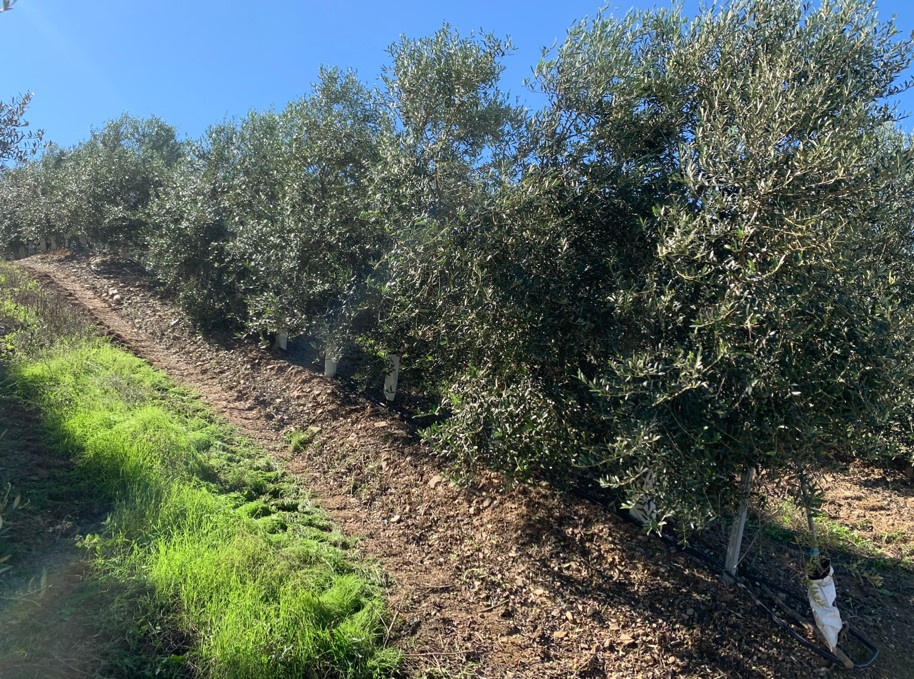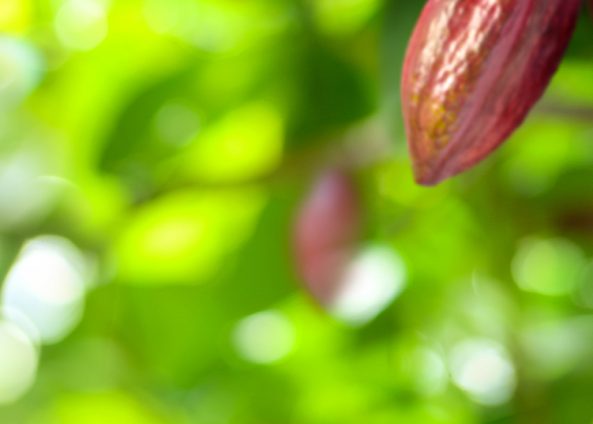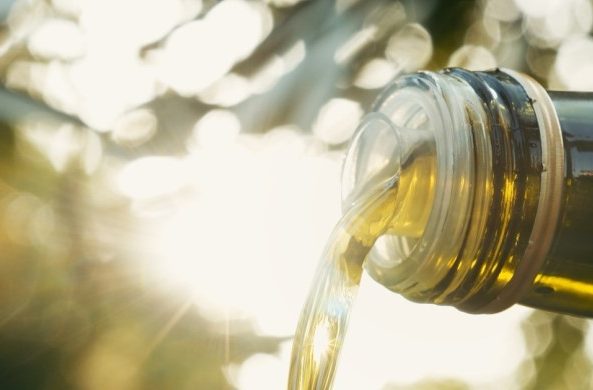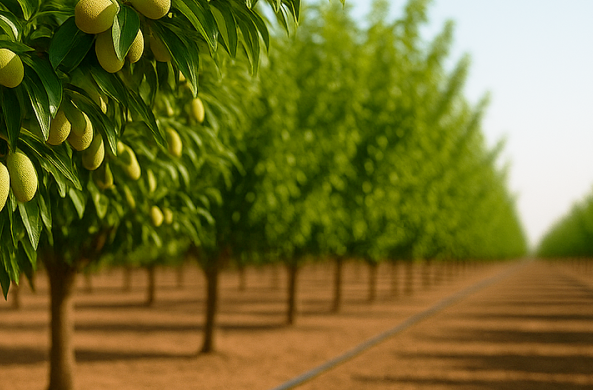
Drip irrigation enabling intensive orchard production
By Rivulis
One of the most significant developments in tree crop horticulture in the last 30 years has been the move to intensive plantings, where trees such as pome and stone fruit, avocados, mangoes, olives and almonds are grown at much closer spacings than previously.
The establishment costs of intensive orchards are high, in part because of the increased tree cost per hectare and in part because they require a significant reset of management practices. The payback, however, is significant in terms of earlier production, higher yield of better quality fruit and nuts and lower harvesting costs.
Two key factors have enabled this revolution in growing technology. The first is the identification and selection of precocious dwarf rootstocks, and the second is the strategic application of drip irrigation. Drip is being used to help establish trees, manage root development and crop nutrition and promote much earlier production than was ever possible with conventional orchards.
This shift in orchard design was led by researchers and producers in Europe, where land suitable for horticulture is of limited availability and can be expensive. For some crops, particularly apples, intensive orchard production is common in most growing areas, from the US and Europe through to China, India, Russia, South Africa, Australia and New Zealand. Additional tree crops using intensive production have since been adopted or are being trialled in the US, Israel, Australia and New Zealand.
Why intensive cropping?
While intensive cropping depends on higher level management skills and water management, the benefits are significant. These include the following:
- Earlier production, where commercially acceptable yields are achieved sooner than could be expected under a conventional system, thus providing an earlier return on investment. For apples, this means a commercial harvest at year 3 rather than years 4 or 5.
- Higher potential yield per hectare. In Europe and New Zealand, for instance, intensive apple orchards can produce more than 100 t/ha of fruit. By comparison, in Australia, a high yield in a very productive, conventionally spaced orchard would only be around 40 t/ha.
- Higher yields and more uniform fruit quality. This is in part the result of better light penetration and careful water management.
- Decreased labour costs for tasks such as canopy management, tree training and harvesting. These tasks are often simpler because of orchard architecture, which usually involves a central leader or two or three leaders with side branches trained to grow into a “wall” on a trellis, rather than the conventional vase system. As well, trees are usually allowed to grow to only 2.0 to 3.5 m high, which makes canopy management easier.
- Ability to use machinery and automation (including robotics) from pruning to harvesting.
Apple orchard in Russia using Rivulis D5000 PC drip line with 1.0 l/h drippers. Drip irrigation has allowed for tree crops such as apples to be established using much closer spacings and to be managed more intensively.
The role of drip irrigation
Along with the use of precocious dwarf rootstocks, intensive plantings have only become possible because of the opportunities that are provided by drip irrigation for managing trees.
Trees in intensive orchards have shallow root systems as a result of the use of dwarf rootstocks. As well, roots are denser because there are more trees per hectare. A conventional apple or pear orchard has about 600 trees/ha, while it is possible to have between 2500 and 3500 trees/ha in an intensive orchard, where rows can be between 3.0 and 4.5 m wide with trees spaced between 0.5 to 2.5 m apart. With these configurations, canopy widths range between 0.75 and 1.5 m.
In Spain, olive trees, which were once planted at between 24 x 24 m and 10 x 10 m spacings, are now being planted at spacings ranging from 7 x 5 m down to 4 x 1.5 m. Critical to the enablement of this transition to intensive spacings is drip irrigation.
Orchardists are using drip irrigation to ensure soil-water status is maintained for optimum production in these more challenging circumstances where trees have shallower and denser root systems.
A management issue with high-density orchards is that trees are more susceptible to water stress compared to lower density orchards. Under a conventional irrigation regime, water uptake by roots under field conditions is not uniform across the soil profile and the initial uptake after irrigation is mainly in the upper layers where root activity is more intensive because of better aeration and the presence of higher levels of organic matter. Drip irrigation allows growers to better manage soil moisture and target water application.
In growing areas with temperate climates where there is adequate spring and summer rain, such as the US, Northern Italy, Northern Spain and New Zealand, the primary role of drip irrigation is to ensure optimum soil moisture for the uptake of nutrients at critical stages as a way of maximising fruit size, quality and yield.
Another important role for drip irrigation in these growing areas is to supply plant nutrients through fertigation. With fertigation, the composition and the concentration of the minerals near and within the active root zone can be managed and controlled. Using soluble fertilisers that are absorbed relatively quickly requires frequent applications to maintain the necessary concentration of nutrients. Drip irrigation provides the flexibility to alter the composition and concentration of the nutrient solution in the irrigated root zone according to crop needs at various stages of growth and development.
Controlling the rate of vegetative growth is therefore possible by quickly changing water availability as well as nitrogen concentration in the irrigated soil volume. Being able to do this underpins strategies to maximise both yield and quality and control vegetative reproduction.
Drip irrigation using Rivulis Hydro PC drip line with 1.6 l/h drippers has enabled the establishment of olive trees planted in Portugal where row widths are 4.0 m and trees are planted 1.25 apart. Importantly, trees are kept relatively short, ensuring there is less vegetative growth and allowing the canopy to be managed more efficiently using machines rather than manual labour.
In Israel, where tree crops are grown in the North, researchers and growers are experimenting with extending the use of drip irrigation as a crop establishment and management tool.
These areas have little spring and no summer rain so almost all crop moisture is supplied through irrigation. This ability to control moisture availability provides much more scope for using drip irrigation to manage fruit production and tree growth from establishment through to maturity.
Strategies that are being applied include using one or two dripper tubes per row depending on the crop, soil type and tree spacing.
The optimum distance between drippers and number of drippers per tree are other factors that are being tested with between 30 and 60 cm spacings being most common using 1.0 to 3.5 l/hr emitters.
As with tree crops in other growing areas, nutrient application through drip is carefully controlled to manage vegetative growth and canopy height, fruit set and fruit development.
Typical drip irrigation layouts for tree crops
The usual design and installation principles for drip irrigation apply to intensive tree crops. Systems must be professionally designed based on factors such as water source and quality, topography, soil type, orchard management parameters and resources available.
Key factors to consider for drip irrigation include the following:
- Crop
- Row spacing and spacing between trees
- Size of drip tube
- Placement (on the ground, underground or above ground on a wire)
- Number of drippers per tree and output (l/hr)
- Other factors such as frost protection in some areas or cooling systems which can be implemented as a dual system with drip for irrigation and micro sprinklers for frost protection and cooling
The bottom line
While the costs of establishing and managing tree crops using an intensive system are higher than for conventional orchard systems, the returns are demonstrated to justify the investment.
One of the technologies that has underpinned the development and expansion of intensive tree cropping around the world is drip irrigation, which allows tree growth and development to manage for optimum production and fruit quality through the precise application of water and nutrients.
Intensive orchards require the maximization of every square meter and there is little room for error. The farms are high investment, and trees are reliant on every dripper to provide sufficient water and injected nutrients. Each tree will only have 1 to 6 drippers, so the importance of high-quality drip lines is paramount, along with excellent hydraulic design, through to every irrigation component being of the highest quality to protect the investment of the farmer.







